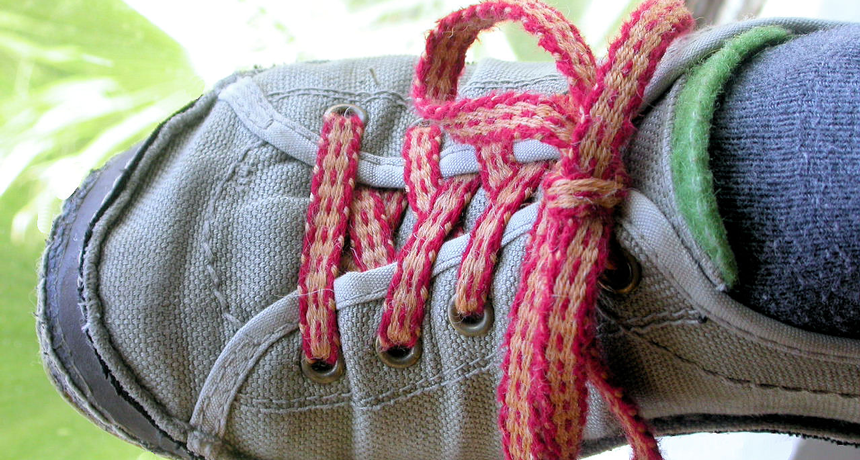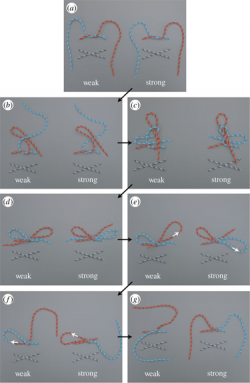Why your shoelaces untie themselves
Super-high-speed video shows how stomping feet and swinging legs loosen shoelace knots

Researchers figured out how laces untie themselves by poring over the film of a runner. As they watched frame-by-frame, the laces eventually slipped free of their knots.
Sand Dragon/Flickr (CC BY-NC 2.0)
Have you ever looked down to see your shoelaces safely knotted, then tripped over them seconds later? Researchers at the University of California, Berkeley wondered why shoelaces seem to come untied so suddenly. In a new study, they found that the repeated impact of a shoe hitting the ground when we walk or run loosens the knot. Then, as we swing our legs, the whipping motion of the laces’ free ends pulls them apart. Within seconds, the knot untangles.
They also found that shoelaces loosen faster when a person runs. That’s because the foot of a runner hits the ground harder than it will during a walk. A running foot hits the ground at about seven times the force of gravity. That force makes the knot stretch and relax more than it would during walking.
Once a knot loosens, it may only take two more strides for the swinging laces to completely come undone.
Before performing the new study, the Berkeley team scoured the internet. Surely, they thought, someone somewhere must have answered why this happens. When no one had, “We decided to figure it out ourselves,” says Christine Gregg. She is a PhD student in mechanical engineering. A mechanical engineer uses physics and knowledge about materials and motion to design, develop, build and test devices.
Gregg teamed up with fellow PhD student Christopher Daily-Diamond and their professor Oliver O’Reilly. Together, the three succeeded in solving the mystery. They shared their discovery April 12 in Proceedings of the Royal Society A.
How they figured it out
The team began by studying Gregg, who is a runner. She laced up her shoes and ran on a treadmill while the others watched. “We noticed that nothing happened for a long time — and then the laces suddenly came untied,” says Daily-Diamond.
They decided to videotape her shoes so they could examine the motion frame by frame. They used a super-high-speed camera that takes 900 images, or frames, per second. Most video cameras record only about 30 frames per second.
With this camera, the team could really slow down the action. This let them watch the knot’s action in slow motion. Our eyes don’t see movement at 900 frames per second. We see in less detail. That’s why it seems as if our shoelaces are firmly tied, and then suddenly aren’t.
And the reason no one figured this out before? It’s only recently that people have been able to shoot video at such high speeds, Gregg explains.
The researchers showed that both the stomping motion and the swinging ends of those laces are needed for a knot to untie. When Gregg sat on a chair and swung her legs back and forth, the knot stayed tied. The knot also stayed tied when she stomped on the ground without swinging her legs.
Story continues below video.
Tie a strong knot
Of course, your shoelaces don’t come untied every time you walk or run. Tightly tied laces need more time to free themselves. There also is a way to tie them so they stay tied longer.
There are two common ways to tie shoelace. One is stronger than the other. Currently, no one knows why.

The weaker bow is based on what’s called a granny knot. Here is how you do it: Cross the left end over the right end, then bring the left end under and out. Make a loop in your right hand. Wrap the other lace counter-clockwise around the loop before you pull it through.
A stronger bow is based on what’s called a square knot. It begins the same way — by crossing the left end over the right end, and bringing the left end under and out. But after making the loop in your right hand, you wrap the other lace clockwise around it.
Both types of bows will eventually come undone. But during a 15-minute running test, Gregg and her team showed that the weaker bow failed twice as often as the stronger one.
Scientists know from trial and error which knots are strong and which are weak. “But we don’t know why,” says O’Reilly. He says it remains “pretty much an open question in science.”
Even though the team didn’t solve that particular mystery, their study is important, says Michel Destrade. He is a mathematician who works in medical research at National University of Ireland in Galway.
He says the team’s research could help scientists better understand how stitches on a wound might come undone. It’s important for these knots to stay put until the wound can heal.
In the meantime, the team is thrilled to have solved some of the mystery around shoelaces. “There is that eureka moment that’s really special — when you go “Oh, that’s it! That’s the answer!” says O’Reilly. Afterward, he says, “You never look at shoelaces the same again.”







